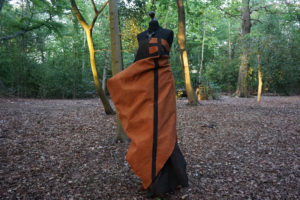
African fashion
African fashion design is flourishing, and has been making waves on the world’s catwalks in recent years. ‘Connecting Afro Futures - Fashion x Hair x Design’ at Berlin’s Museum of Decorative Arts, the Kunstgewerbemuseum, provides current insights and examines the background to this upswing.
At the beginning of Americanah, the multi-award-winning novel by Chimamanda Ngozi Adichie, we find ourselves in a hairdressing salon. Not just any hairdressing salon, but the only one in the US university town of Princeton specialising in African braided hairstyles. One of the salon’s customers is Ifemelu from Nigeria. As a black student who didn’t grow up in the USA, she blogs about the everyday racism in the country. It starts with the hair.
We learn that for upwardly mobile black women in the USA, the traditional African hairstyle of plaits elaborately braided close to the scalp is as much a taboo as the afro. So these women have their hair chemically straightened, or use hair straighteners to do it. Even former First Lady Michelle Obama was unable, or unwilling, to resist the pressure, as Ifemelu’s blog points out.
In Europe, the situation is a bit more relaxed: if you look around while walking through any larger town, you will soon notice that more and more salons specialising in African hair are popping up. Women of African descent are now wearing their ornate braided hairstyles with pride. The trend has even been taken up by white women: Greta Thunberg isn’t the first to rock a plait, and scores of others are following suit. There’s a clear cultural crossover towards braids and the African braiding techniques known as ‘cornrows’. Increasingly, the fashion world too is taking its inspiration from Africa.

José Hendo, Signs of the Now, 2019, © Terimelda Hendo
What’s behind these trends? Berlin’s Kunstgewerbemuseum takes a closer look, in a compact yet provocative exhibition. Even the title ‘Connecting Afro Futures – Fashion x Hair x Design’ makes it clear that the exhibition is about more than just stylish looks. The discussion revolves around the West’s image of Africa, and its transformation through post-colonial discourses, because Africa’s future development will depend to some extent on what images and narratives about Africa emerge, circulate and radiate beyond the continent. One approach may be to tie in with local cultural and creative traditions. At the same time, it’s important to avoid the well-known pitfalls of ethno-kitsch. ‘Afrofuturism’ is the prevalent, albeit not wholly unproblematic, general term for this reimagining. The video interviews conducted by Ken Aïcha Sy, and the catalogue, provide background information.
The exhibition, the first part of which is mainly dedicated to hair, makes a very solid start with a collection of combs. All are particularly chunky – and here we go straight to the heart of the matter. Obviously, you’re not going to get very far using a fine comb on naturally frizzy hair! An ornately designed set of Senegalese combs, one for each day of the week, is a sign of the deep relationship people have with their hair, shaped as it is by long-standing traditions. An afro comb with a clenched fist as a handle harks back to the Black Power movement of the 1960s, a movement whose visible trappings included the afro look propagated at the time by Angela Davis. Unleashed hair, unleashed energies of protest – that was the immediate message.
Right alongside this, Funmi Oyewale explores, in unsettling photo collages, how it is the untameable African hair that provides the fodder for equally wild fantasies. In Oyewale’s works, the woven braids with which the stubborn hair is traditionally trained into elaborate shapes have metamorphosed into grotesque and menacing ulcerations. This visual excess takes aim at both Western voyeurism, and African desire for dramatic self-presentation.
More pleasant, but no less subversive, are the Carnivalesque braided wigs of artist Meschac Gaba, well-known for many years for his conceptual Museum of Contemporary African Art. The wigs imitate architectural monuments created by Western powers, and cleverly blend African and colonial symbols of cultural hegemony.
In the second part of the exhibition, the emphasis increasingly shifts to fashion. A recurring punchline is that the set phrases of hair design also appear in fashion. There are interesting experiments with traditional materials – a barkcloth that feels like very fine felt, for instance. The question of whether these sometimes quite eccentric designs would be worn in Paris, London or Zurich is the wrong one altogether. These fashions are intended to appeal to an African middle class seeking to emancipate itself from the dictates of Western fashion. It also marks a distancing from the missionary-era ‘picture postcard’ Africa of multi-coloured fabrics and patterns. The theme of a separate, African fashion identity is highly visible. The completely black collection presented by Lamula Anderson goes against the idea, commonly held in Africa, that only the brightest, most garish colours will suit black-skinned people.
The effort to find a way between tradition and the Western fashion mainstream is leading African designers to produce idiosyncratic, albeit occasionally over the top, creations. These pieces almost always have to act as a statement. Designers are working with a history in which the external and the innate are inextricably entangled. The economic potential of some designs therefore seems limited. Moreover, it turns out that very often, the actual added value isn’t felt in Africa. Photographers and western fashion magazines in particular still hold fast to a trend whereby these designs are merely ‘eye candy’, which they use to flaunt their cultural open-mindedness almost as an afterthought. Nothing is said of the fact that in the past few decades well-intentioned European shipments of old clothes have all but destroyed whatever textile industry still exists in Africa. This makes projects such as that run by Njola Impressions, which specialise in the currently highly topical field of recycling design, all the more relevant.
When expressing an African sense of style, the key role of music videos in particular, of which the exhibition shows a hand-picked selection, cannot be overestimated. But internet platforms and sales channels do more than just contribute to identity creation and better networking of the African diaspora; especially for small labels, they also provide direct market access.

Meschac Gaba, Perruques d’Architecture (Café Moskau), 2019, © Charles Placide / VG Bild-Kunst Bonn 2019

Lamula Anderson, © Lamula Anderson, Foto: Magic Owen
The Berlin Museum of Decorative Arts, with its recently refurbished gallery of historic European fashion, is itself taking another step into the future with this exhibition. European fashion was connected with the non-European world early on, as a luxury industry initially driven by a courtly aesthetic and later increasingly influenced by middle-class tastes. The fabrics and patterns used, whether from China, India – as currently on display in the ‘Indiennes’ exhibition at the National Museum Zurich – or Africa, often had a veritable journey round the world behind them. In the twentieth century, the pendulum swung back the other way: Western fashion styles and labels advanced into the globalised shopping malls of the rest of the world, where often, however, only an affluent local upper class could afford them. It’s no wonder Africa is still perceived, in fashion terms, mainly as a dumping ground for Europe’s old clothes. After visiting the Berlin exhibition, one thing is certain: there’s a lot more innovation going on there than is often realised from a European perspective.



